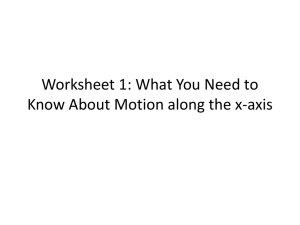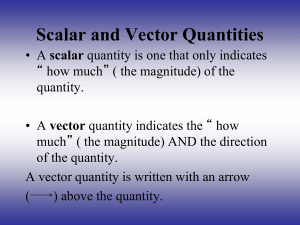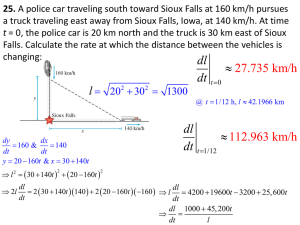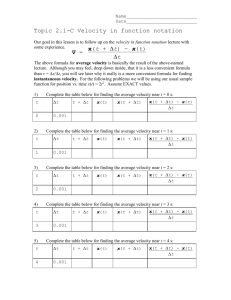MASSACHUSETTS INSTITUTE OF TECHNOLOGY
advertisement
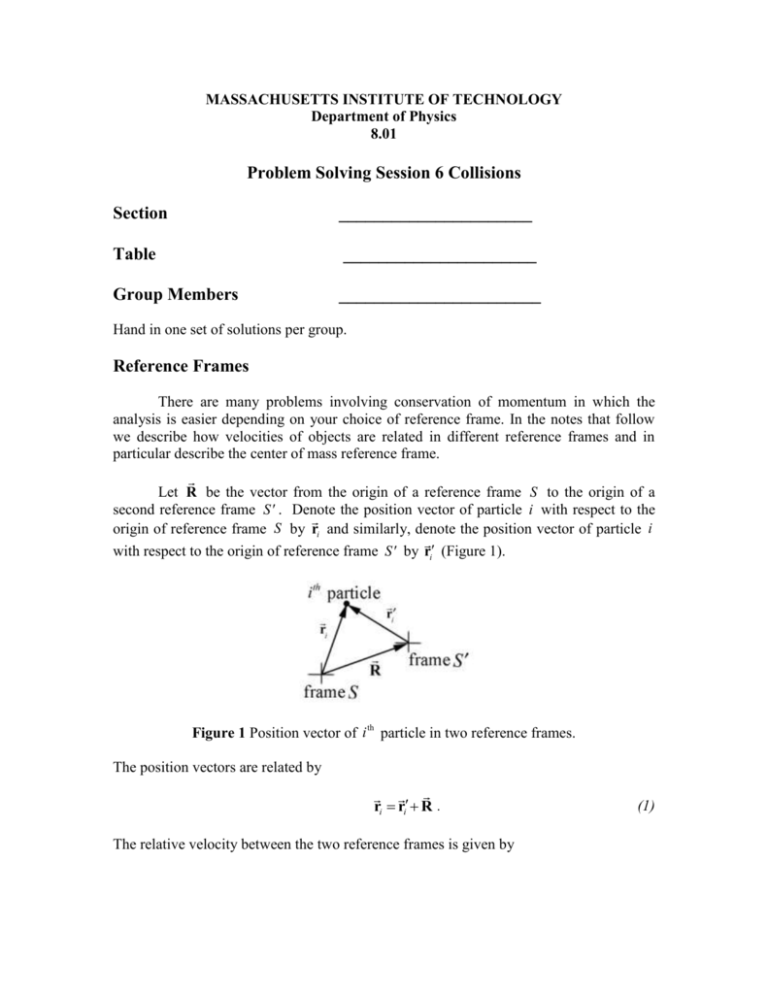
MASSACHUSETTS INSTITUTE OF TECHNOLOGY Department of Physics 8.01 Problem Solving Session 6 Collisions Section ______________________ Table ______________________ Group Members _______________________ Hand in one set of solutions per group. Reference Frames There are many problems involving conservation of momentum in which the analysis is easier depending on your choice of reference frame. In the notes that follow we describe how velocities of objects are related in different reference frames and in particular describe the center of mass reference frame. Let R be the vector from the origin of a reference frame S to the origin of a second reference frame S . Denote the position vector of particle i with respect to the origin of reference frame S by ri and similarly, denote the position vector of particle i with respect to the origin of reference frame S by ri (Figure 1). Figure 1 Position vector of i th particle in two reference frames. The position vectors are related by ri ri R . The relative velocity between the two reference frames is given by (1) V dR . dt (2) When the relative velocity between the two reference frames is constant then the relative acceleration between the two reference frames is zero, A dV 0 , dt (3) When Eq. (3) is satisfied, the reference frames S and S are called relatively inertial reference frames. Suppose the i th particle in Figure 1 is moving; then observers in different reference frames will measure different velocities. Denote the velocity of i th particle in r r frame S by v i dri / dt , and the velocity of the same particle in frame S by r r v i dr / dt . Since the derivative of the position is velocity, the velocities of the particles in two different reference frames are related according to vi vi V . (4) This relation is called the law of addition of velocities and is the primary tool that we will use when we describe velocities in different reference frames. r Example: Suppose a cart has velocity V Vφ i with respect to the ground. Let S denote a reference frame fixed to the ground and let S denote the reference frame moving with r velocity V Vφ i with respect to the ground. In S the cart is at rest. Suppose aball is r thrown from the cart with velocity u uφ i relative to the cart. Then the velocity of the ball relative to the ground reference frame S is r r r u u V uφ i Vφ i (V u)φ i. (5) Center of Mass Reference Frame r Consider a system of N particles. Let R cm be the vector from the origin of a r reference frame S to the center of mass of the system of particles. Let r j denote the position of the j th particle. Recall the definition of the position of the center of mass j N r R cm r mr j 1 j j j N m j 1 j 1 mT j N r mr j 1 j j (6) where mT j N m j 1 j is the mass of the system. The velocity of the center of mass is given by r 1 Vcm mT j N r m v j 1 j j (7) r where v j is the velocity of the j th particle with respect to reference frame S . Choose the center of mass to be the origin of reference frame S cm , called the center of mass reference frame. Denote the position vector of particle i with respect to origin of r reference frame S by ri and similarly, denote the position vector of particle i with r respect to origin of reference frame S cm by rcm,i (Figure 2). Figure 2 Position vector of ith particle in the center of mass reference frame. The position vector of particle i in the center of mass frame is then given by r r r rcm,i ri R cm . (8) The velocity of particle i in the center of mass reference frame is then given by r r r v cm,i v i Vcm . (9) IC_W07D3-1 Group Problem: Railroad Gun A railroad gun of mass m1 fires a shell of mass m2 at an angle of with respect to the horizontal as measured in a reference frame moving with the final velocity of the r gun v1 f after the shell has been fired. After the firing is complete, the final speed of r r the projectile relative to the gun (muzzle velocity) is v 2 (with speed u v 2 ). The r gun recoils with speed v f v1 f and the instant the projectile leaves the gun, it makes an angle with respect to the ground. r a) What is the velocity, v 2 , of the projectile with respect to the ground? b) Find v f and in terms of m1 , m2 , u , and . Problem 2 This problem is on pset 7 and is a difficult problem so we will get you started today. A thin target of lithium is bombarded by helium nuclei of energy E0 . The lithium nuclei are initially at rest in the target but are essentially unbound. When a helium nucleus enters a lithium nucleus, a nuclear reaction can occur in which the compound nucleus splits apart into a boron nucleus and a neutron. The collision is inelastic, and the final kinetic energy is less than E0 by 2.8 MeV . ( 1 MeV=106 eV=1.6 10-13 J ). The relative masses of the particles are: helium, mass 4 ; lithium, mass 7 ; boron mass 10 ; neutron, mass 1 . The reaction can be symbolized 7 Li +4 He 10 B 1 n 2.8 MeV . Let’s consider only the outgoing particles, boron and neutrons that are moving along the same line as the initial helium nucleus, (call this the x -direction). a) Draw momentum diagrams for the initial and final states in a reference frame in which the target lithium nucleus is initially at rest. b) What is the center of mass velocity of the system of lithium and helium? Does this velocity change due to the collision? c) Draw momentum diagrams for the initial and final states in a reference frame moving with the velocity of center of mass. d) What are the velocities of the helium nucleus and the lithium in the center of mass reference frame? What is the momentum of the system in the center of mass reference frame? e) The minimum initial kinetic energy necessary for the reaction to take place is called the threshold energy, E0,threshold . Draw a momentum diagram for the initial and final states in the center of mass reference frame when the initial kinetic energy of the incident particles is at the threshold energy (keep in mind the lithium target is also moving in the center of mass reference frame). Hint: What are the velocities of the outgoing particles at threshold? f) Write down equations for conservation of energy and momentum in the center of mass frame when the initial kinetic energy of the incident particles is at the threshold energy. What is the threshold energy in the center of mass reference frame? g) Draw momentum diagrams for the initial and final states in the center of mass reference frame when the initial kinetic energy of the incident particles lies in the range E0,threshold E0 E0,threshold 0.27 MeV . How many possible final states are there? (Hint: Which way is the neutron moving?) h) Draw momentum diagrams for the initial and final states in which the target is initially at rest for the case of part g). How many possible final states are there? (Hint: Which way is the neutron moving?) i) What is the initial kinetic energy of the helium in this reference frame at threshold? How many possible final states are there? (Hint: Which way is the neutron moving?)


